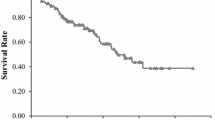Abstract
Background
Reactive oxygen species stimulate lymphatic metastasis by accelerating epithelial-to-mesenchymal transition and lymphangiogenesis in the tumor microenvironment. Hence, systemic oxidative stress level may correlate with nodal involvement in patients with a malignant tumor.
Methods
We examined 46 patients with clinical stage I lung adenocarcinoma who had undergone pulmonary resection with mediastinal lymph node dissection. Serum reactive oxygen metabolite (ROM) level was measured as an indicator of systemic oxidative stress. We investigated the association between nodal involvement and clinicopathological factors.
Results
Preoperative serum carcinoembryonic antigen (CEA; P = 0.045), cytokeratin 19 fragment (CYFRA21–1; P = 0.038), and ROM (P = 0.007) levels were significantly higher in patients with nodal involvement than in those without nodal involvement. A receiver operating characteristic curve was constructed to determine whether patients with and without nodal involvement could be differentiated on the basis of their serum ROM levels. The area under curve was 0.763 and the prognostic cut-off value was set at 318 Carratelli units. In univariate analysis, clinical stage IB (odds ratio [OR] = 4.55; P = 0.033), CEA-positive (OR = 5.56, P = 0.018), and ROM-positive (OR = 10.46, P = 0.006) were significant predictive factors for nodal involvement. In multivariate analysis, ROM-positive was an independent predictive factor for nodal involvement (OR = 6.22, P = 0.045).
Conclusion
Preoperative serum ROM level was an independent significant predictive factor for nodal involvement in patients with clinical stage I lung adenocarcinoma. Hence, serum ROM level may be a useful biomarker for staging of lung adenocarcinoma.

Similar content being viewed by others
References
Tse JC, Kalluri R (2007) Mechanisms of metastasis: epithelial-to-mesenchymal transition and contribution of tumor microenvironment. J Cell Biochem 101:816–829
Rouzaut A, Irigoyen M, Montuenga LM (2007) Lymphangiogenesis and lung cancer. J Thorac Oncol 2:384–386
Christiansen JJ, Rajasekaran AK (2006) Reassessing epithelial to mesenchymal transition as a prerequisite for carcinoma invasion and metastasis. Cancer Res 66:8319–8326
Radisky DC, Levy DD, Littlepage LE et al (2005) Rac1b and reactive oxygen species mediate MMP-3-induced EMT and genomic instability. Nature 436:123–127
Achen MG, Stacker SA (2008) Molecular control of lymphatic metastasis. Ann NY Acad Sci 1131:225–234
Gencer M, Ceylan E, Aksoy N et al (2006) Association of serum reactive oxygen metabolite levels with different histopathological types of lung cancer. Respiration 73:520–524
World Health Organization (1999) Histological typing of lung and pleural tumors, 3rd edn edn. World Health Organization, Geneva
Mountain CF (1997) Revisions in the international system for staging lung cancer. Chest 111:1710–1717
Naruke T, Suemasu K, Ishikawa S (1976) Surgical treatment for lung cancer with metastasis to mediastinal lymph nodes. J Thorac Cardiovasc Surg 71:279–285
Yanbaeva DG, Dentener MA, Creutzberg EC et al (2007) Systemic effects of smoking. Chest 131:1557–1566
West IC (2000) Radicals and oxidative stress in diabetes. Diabet Med 17:171–180
Inoue T, Hayashi M, Takayanagi K et al (2003) Oxidative DNA damage is induced by chronic cigarette smoking, but repaired by abstention. J Health Sci 49:217–220
Trotti R, Carratelli M, Barbieri M (2002) Performance and clinical application of a new, fast method for the detection of hydroperoxides in serum. Panminerva Med 44:37–40
Poli G, Leonarduzzi G, Biasi F et al (2004) Oxidative stress and cell signalling. Curr Med Chem 11:1163–1182
Szatrowski TP, Nathan CF (1991) Production of large amounts of hydrogen peroxide by human tumor cells. Cancer Res 51:794–798
Weissmann G, Smolen JE, Korchak HM (1980) Release of inflammatory mediators from stimulated neutrophils. N Engl J Med 303:27–34
Nishikawa M (2008) Reactive oxygen species in tumor metastasis. Cancer Lett 266:53–59
Mantovani G, Macciò A, Madeddu C et al (2002) Quantitative evaluation of oxidative stress, chronic inflammatory indices and leptin in cancer patients: correlation with stage and performance status. Int J Cancer 98:84–91
Mantovani G, Macciò A, Lai P et al (1998) Cytokine activity in cancer-related anorexia/cachexia: role of megestrol acetate and medroxyprogesterone acetate. Semin Oncol 25:45–52
Sakao Y, Tomimitsu S, Takeda Y et al (2004) Carcinoembryonic antigen as a predictive factor for postoperative tumor relapse in early-stage lung adenocarcinoma. Eur J Cardiothorac Surg 254:520–522
Kamiyoshihara M, Kawashima O, Otani Y et al (2002) Clinical significance of the preoperative serum-soluble intercellular adhesion molecule-1 in non-small cell lung cancer. J Cardiovasc Surg 43:729–734
Tamura M, Oda M, Matsumoto I et al (2004) The combination assay with circulating vascular endothelial growth factor (VEGF)-C, matrix metalloproteinase-9, and VEGF for diagnosing lymph node metastasis in patients with non-small cell lung cancer. Ann Surg Oncol 11:928–933
Tamura M, Ohta Y (2003) Serum vascular endothelial growth factor-C level in patients with primary nonsmall cell lung carcinoma: a possible diagnostic tool for lymph node metastasis. Cancer 98:1217–1222
Tamura M, Oda M, Tsunezuka Y et al (2004) Chest CT and serum vascular endothelial growth factor-C level to diagnose lymph node metastasis in patients with primary non-small cell lung cancer. Chest 126:342–346
Sasaki H, Yukiue H, Mizuno K et al (2003) Elevated serum epidermal growth factor receptor level is correlated with lymph node metastasis in lung cancer. Int J Clin Oncol 8:79–82
Crohns M, Saarelainen S, Kankaanranta H et al (2009) Local and systemic oxidant/antioxidant status before and during lung cancer radiotherapy. Free Radic Res 43:646–657
Acknowledgments
We thank Ms. K. Yamada, Osaka City University Medical School, for her excellent technical assistance.
Conflict of interest
The authors have no relevant financial or other potential conflicts of interest.
Author information
Authors and Affiliations
Corresponding author
About this article
Cite this article
Tsukioka, T., Nishiyama, N., Iwata, T. et al. Preoperative serum oxidative stress marker as a strong indicator of nodal involvement in clinical stage I lung adenocarcinoma. Int J Clin Oncol 17, 250–255 (2012). https://doi.org/10.1007/s10147-011-0283-6
Received:
Accepted:
Published:
Issue Date:
DOI: https://doi.org/10.1007/s10147-011-0283-6




